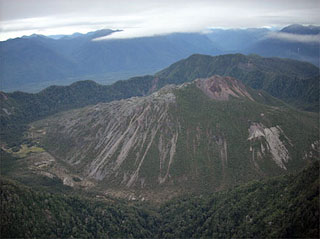Report on Chaiten (Chile) — 2 July-8 July 2008
Smithsonian Institution / US Geological Survey
Weekly Volcanic Activity Report, 2 July-8 July 2008
Managing Editor: Sally Sennert.
Please cite this report as:
Global Volcanism Program, 2008. Report on Chaiten (Chile) (Sennert, S, ed.). Weekly Volcanic Activity Report, 2 July-8 July 2008. Smithsonian Institution and US Geological Survey.
Chaiten
Chile
42.8349°S, 72.6514°W; summit elev. 1122 m
All times are local (unless otherwise noted)
SERNAGEOMIN reported that during 27 June-4 July, visual observations of Chaitén were inhibited due to inclement weather. During 27-28 June, lahars descended multiple drainages and were especially notable in the Chaitén and Amarrillo rivers. On 30 June, an ash plume that rose to an altitude of 2.1 km (6,900 ft) a.s.l. was observed by means of a video camera in the city of Chaitén. A photograph of the new lava dome revealed that it completely covered the S side of the old lava dome. Lahar deposits were seen in the W part of the caldera and a drainage in the S caldera was blocked by rockfalls, causing small ponds to form. On 2 July, ash plumes that rose to altitudes of 4.1 km (13,500 ft) a.s.l. originated from a previously active area on the S flank and from a new area farther W. The plumes drifted N and NE.
Based on web camera views, SIGMET reports, observations of satellite imagery, pilot reports, and information from the Puerto Montt Flight Information Region (FIR), the Buenos Aires VAAC reported that during 2-3, 5, and 8 July ash plumes rose to altitudes of 2.1-4 km (7,000-13,000 ft) a.s.l. and drifted ENE, E, and SE.
Geological Summary. Chaitén is a small caldera (~3 km in diameter) located 10 km NE of the town of Chaitén on the Gulf of Corcovado. Multiple explosive eruptions throughout the Holocene have been identified. A rhyolitic obsidian lava dome occupies much of the caldera floor. Obsidian cobbles from this dome found in the Blanco River are the source of artifacts from archaeological sites along the Pacific coast as far as 400 km from the volcano to the N and S. The caldera is breached on the SW side by a river that drains to the bay of Chaitén. The first recorded eruption, beginning in 2008, produced major rhyolitic explosive activity and building a new dome and tephra cone on the older rhyolite dome.
Sources: Servicio Nacional de Geología y Minería (SERNAGEOMIN), Buenos Aires Volcanic Ash Advisory Center (VAAC)

